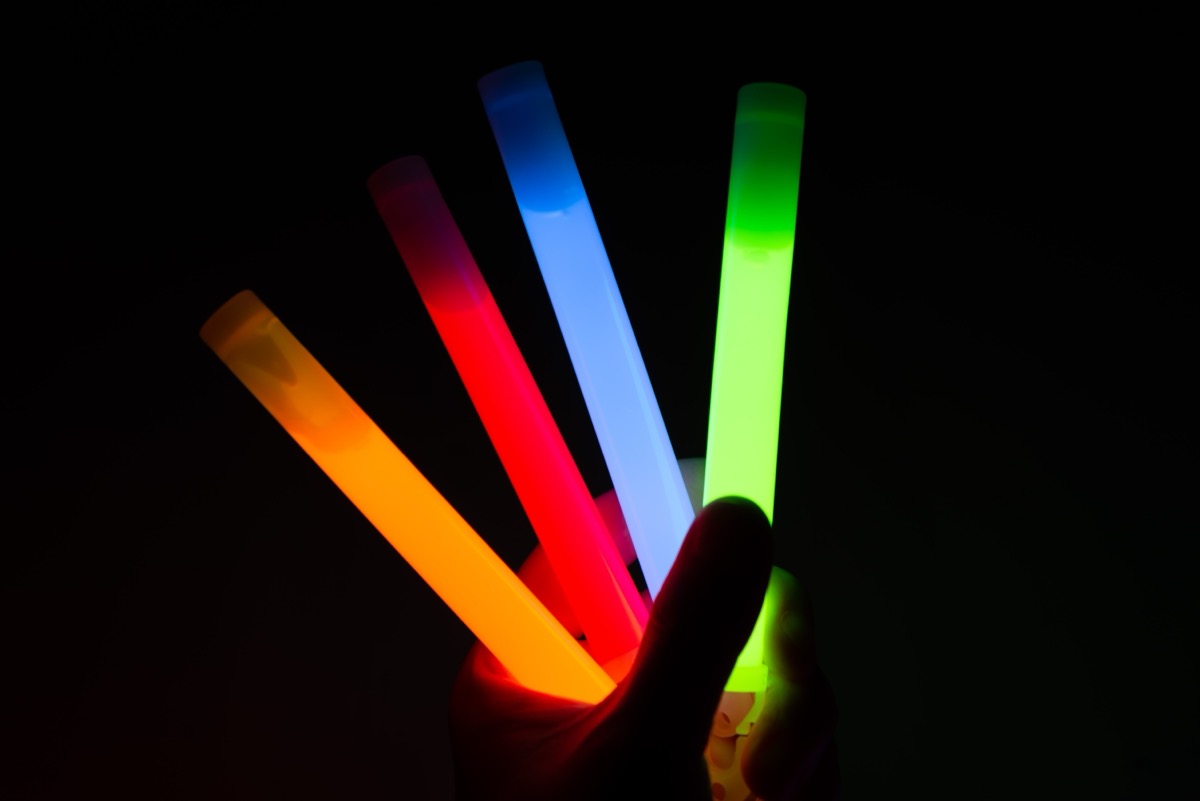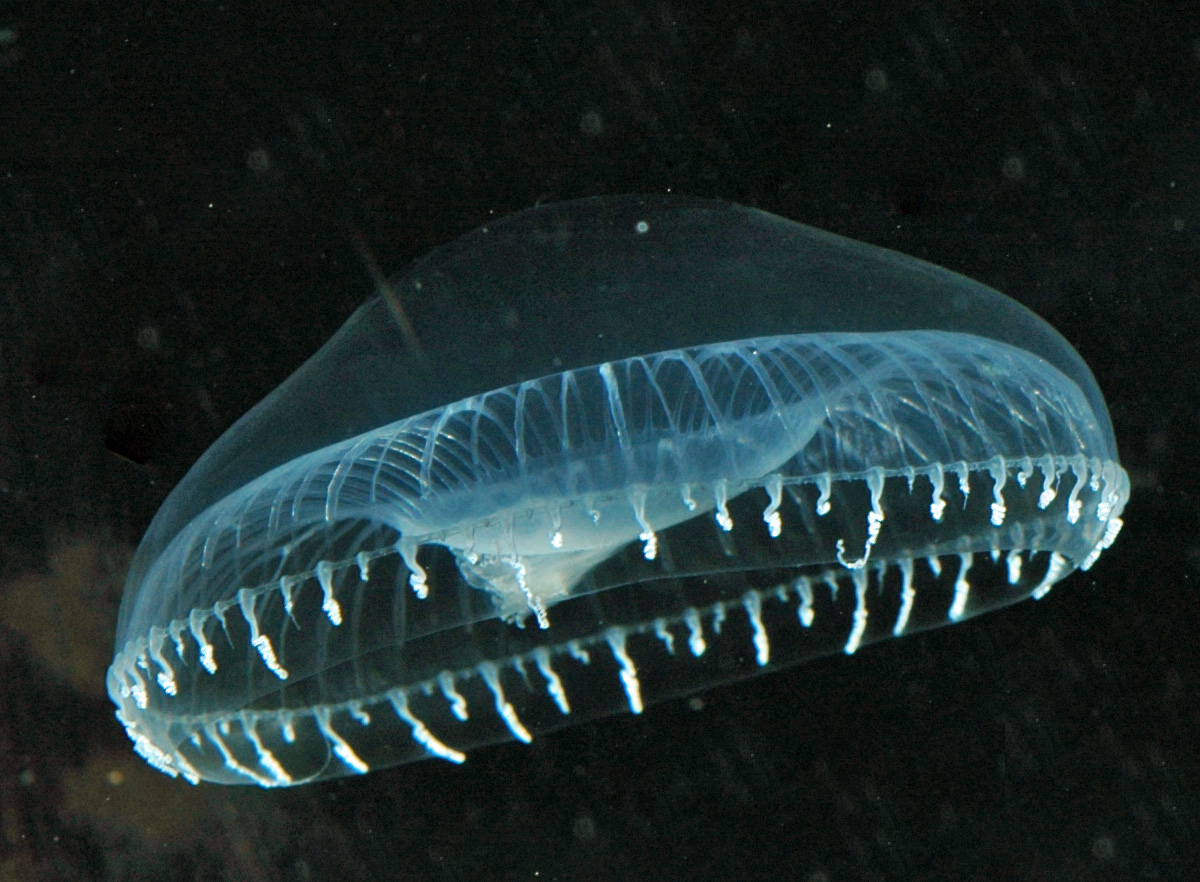Luminescence is the emission of light produced by means other than heat. Bioluminescence is just one of the many forms of luminescence. Often, these types of luminescence are mistakenly grouped together but each one differs in their method of emitting light.
In this activity, students will compare and contrast different forms of luminescence by observing how chemiluminescence, phosphorescence, and fluorescence produce or emit light. Students will also compare these forms of luminescence to bioluminescence.
Materials
- Light sticks – one for each student
- Objects that glow in the dark, such as stickers or plastic stars
- Paper bag
- Flashlights – one for each student
- Laundry detergent that contains whitening agents
- Small transparent plastic cups – one for each student
- Black light (UV light)
- If possible: a sample of a fluorescent mineral, such as those found at the defunct Sterling Hill Mine in Franklin, New Jersey.

Procedure
Begin the lesson by having students watch the Science Friday video above, “A Quest To See The Light.” Ask students to describe other types of creatures that use bioluminescence. How do these and other animals produce light? Review the definition of bioluminescence, and explain that it is one of many forms of luminescence. Tell students that they will conduct activities to compare the similarities and differences among other forms of luminescence.
Have students create a chart with three columns. Label each column as 1) chemiluminescence, 2) phosphorescence, and 3) fluorescence.
Activity 1: Chemiluminescence
- Hand out a light stick to each student. Have them observe and record on their chart a description of the light stick, including color and transparency. Have students shake their light sticks. Are there any reactions? Ask students to suggest what action is necessary in order to activate the light stick.
- Have students bend the light stick and observe the reaction. (Do not allow students shake the light stick.) Does the light or glow spread to the rest of the stick, or does it remain focused on the part of the stick that was bent? Ask students to predict what will happen if they shake the light stick.
- Have students shake the light stick and record their observations, including any changes in color and temperature.
Activity 2: Phosphorescence
- Show students an object that glows in the dark. Ask students how they think they can cause the object to glow or emit light. Turn the lights off and quickly take out one of these objects that has been stored in a dark paper bag. Does it glow brightly? What will make it glow brighter?
- Turn lights on again, and hand out to each student one object that glows in the dark, along with a flashlight. Instruct students to shine the flashlight directly on the object for one minute, and then explain what they think is happening.
- Remove the flashlight after one minute, and turn the lights off to observe the results. Have students record their observations of the object before and after using the flashlight. Include observations on temperature, brightness, and method of activation. How was this type of luminescence different from the light stick’s luminescence?
Activity 3: Fluorescence
- Hand out to each student a small transparent plastic cup filled with laundry detergent. Have students record the color and temperature (hot, cold, warm) of the detergent. Ask students to explain how the laundry detergent could glow.
- Shine the black light onto a laundry detergent sample. Ask students to describe what they see. Why does the laundry detergent appear to glow?
- Turn the black light off and have students observe the laundry detergent. Does it continue to emit light? Why do they think the laundry detergent no longer appears to glow? Have students record their observations and explanations.
- Shine the black light on other objects in the room such as clothes, hands, furniture, etc. If you have a sample of a fluorescent mineral, shine the black light on it. What causes some of these other objects to appear as if they are glowing? How is this type of luminescence different from what the students observed during the two prior activities?
Understanding Types Of Luminescence
Luminescence is the emission of light produced by methods other than heat. Luminescence is caused by the movement of electrons into different energetic states. There are many different types of luminescence including bioluminescence, chemiluminescence, phosphorescence, and fluorescence. These various forms of luminescence differ in their method of emitting light.
Chemiluminescence is the emission of light caused by a chemical reaction. This type of luminescence can be observed by bending and shaking a light stick. Inside the light stick is an encapsulated chemical solution, surrounded by a different chemical solution. Bending the light stick causes the encapsulated chemical solution to break open. Shaking the light stick then causes the two solutions inside the stick to mix. When these chemicals combine, energy is created in the form of light. Organisms that emit light, known as bioluminescent organisms, also produce light through a chemical reaction.

Phosphorescence is the ability of a material to absorb energy from an electromagnetic radiation source, such as a flashlight, and then continue to emit light after the source has been removed. In this activity, the glow in the dark object absorbs or stores the energy from the flashlight and then gradually re-emits the energy as light, even after the flashlight has been turned off.
Fluorescence is similar to phosphorescence, in that it is the ability of a material to emit light by absorbing energy from a source of electromagnetic radiation. However, unlike phosphorescence, fluorescent materials can only emit light during the time that they are exposed to the source of electromagnetic radiation. A fluorescent material will stop “glowing” once the light source is removed.
Here are some questions to ask yourself:
- Are bioluminescent animals only found in the ocean?
- How do bioluminescent animals use their ability to emit light?
- What are other examples of natural and synthetic luminescence?
- How long will a phosphorescent object continue to glow after exposure to a light source?
Extended Activities and Links
- Have each student research a bioluminescent animal and create a presentation that includes its habitat, diet, and how it uses its bioluminescent ability to survive. Include photos or illustrations of the bioluminescent animal to share with the rest of the class.
- Create a mural of an underwater scene that represents a variety of bioluminescent sea animals. Have students design the layout according to the layers of the ocean in which the animals are found, and use paint that glows in the dark to represent the parts of the animals’ bodies that emit light. Make sure to review with students the difference between paint that glows in the dark (a type of phosphorescent material) and bioluminescence, which is caused by a chemical reaction.
- Learn more about bioluminescent creatures from National Geographic.
- Discover the chemistry behind bioluminescence.
- Follow an expedition to study bioluminescence on the deep-sea floor.
- Consider a field trip to a science museum or mineral show to see fluorescent minerals.
Vocabulary
- Luminescence: the emission of light produced by means other than heat.
- Fluorescence: the emission of light by an object exposed to electromagnetic radiation.
- Phosphorescence: the continued emission of light without heat after exposure to and removal of a source of electromagnetic radiation.
- Chemiluminescence: the emission of light as a result of a chemical reaction.
- Bioluminescence: the emission of light by living organisms.
This lesson plan was created by the New York Hall of Science in collaboration with Science Friday as part of Teachers Talking Science, an online resource for teachers, homeschoolers, and parents to produce free materials based on very popular SciFri Videos to help in the classroom or around the kitchen table.
The New York Hall of Science is a science museum located in the New York City borough of Queens. NYSCI is New York City’s only hands-on science and technology center, with more than 400 hands-on exhibits explore biology, chemistry, and physics.
Meet the Writer
About Ariel Zych
@arieloquentAriel Zych is Science Friday’s director of audience. She is a former teacher and scientist who spends her free time making food, watching arthropods, and being outside.
